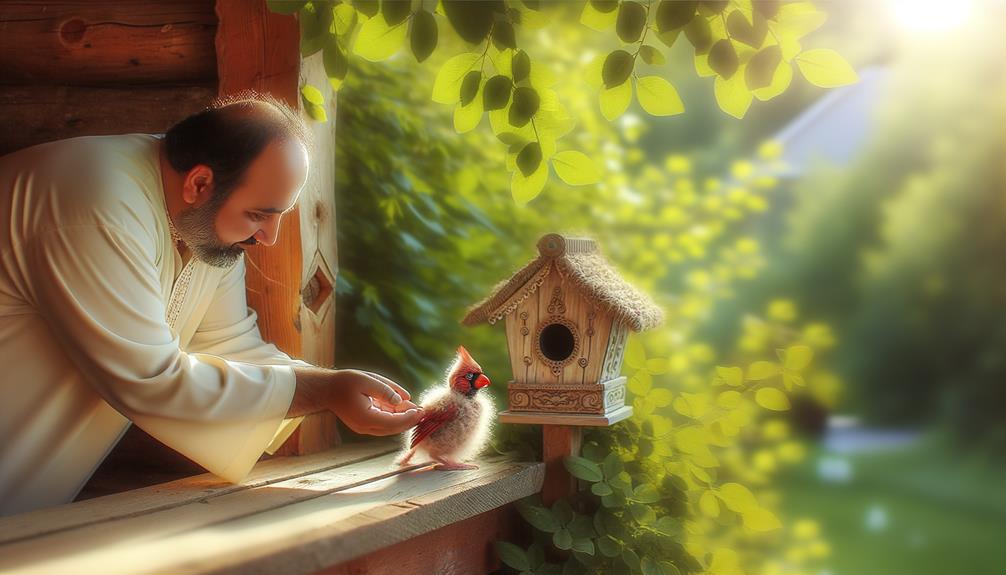10 Steps to Hand-Feed My Baby Cardinal: How Long Do I Need?
You should hand feed your baby cardinal until it shows signs of self-feeding, typically around three to four weeks old. Initially, feed every 15-20 minutes from sunrise to sunset using a specialized passerine bird formula.
Gradually reduce to every 45-60 minutes as the bird grows and its feathers develop. Watch for signs of independence, such as pecking at food and decreased begging.
Ensure a balanced diet with high-protein foods and proper hydration. Gradually decrease hand-feeding frequency while encouraging self-feeding behaviors.
Observing these developmental cues will guide you in shifting your baby cardinal to independence. For detailed guidance, continue ahead.

Key Takeaways
- Hand feed every 15-20 minutes initially, reducing frequency as the bird grows and shows signs of independence.
- Monitor for self-feeding behaviors like pecking at food and decreased begging to gauge readiness to reduce hand-feeding.
- Gradually extend feeding intervals to every hour as the bird gains weight and develops feathers.
- Transition to self-feeding by introducing small, soft food pieces while decreasing hand-feeding.
- Observe for full feather development and increased activity levels as indicators of feeding independence.
Understanding Baby Cardinal Development
To understand baby cardinal development, you'll need to grasp the key stages of their early growth, from hatching to fledging. Initially, cardinals hatch blind and featherless, relying entirely on their parents for warmth and sustenance.
Within the first week, their eyes start to open, and pin feathers begin to emerge. By the second week, these feathers unfurl, and the baby begins to show more mobility and awareness. Around day 10 to 12, they start to preen and stretch their wings.
Initial Feeding Techniques
When hand-feeding a baby cardinal, make sure you use a specialized formula designed for passerine birds to provide the necessary nutrients for their development.
Prepare the formula according to the manufacturer's instructions, ensuring it's at the correct consistency and temperature.
Use a small, sterile syringe or dropper to feed the baby bird, aiming for the side of the beak to avoid aspiration.
Gently tap the beak to stimulate the feeding response, and dispense small amounts of formula at a time.
Be patient and attentive, as the baby cardinal's swallowing reflex may be slow.
Clean the bird's beak and surrounding feathers after each feeding to prevent bacterial growth and maintain hygiene.
Repeat these steps consistently for best health.
Frequency of Feedings
You'll need to feed a baby cardinal every 15-20 minutes from sunrise to sunset during its early stage.
As it grows, gradually reduce the frequency of feedings by extending the intervals between them.
Watch for signs of independence, such as self-feeding behaviors and decreased vocalizations.
Early Stage Needs
In the early stages, a baby cardinal should be fed every 20 to 30 minutes from dawn until dusk to guarantee proper growth and development.
You need to provide a diet rich in protein, ideally using a specialized hand-feeding formula available at pet stores.
Always use a clean, sterilized syringe or dropper to administer the food to prevent infections.
Make sure the formula is slightly warm, mimicking the regurgitated food from parent cardinals.
It's pivotal to monitor the chick's crop, a small pouch in the throat, ensuring it's filling properly but not overextended.
Consistent, frequent feedings are essential for maintaining the bird's energy levels and supporting rapid growth during this critical developmental phase.
Gradual Reduction Timing
As the baby cardinal matures, gradually reduce the frequency of feedings to every 45 minutes to an hour, making sure the chick adapts to longer intervals between meals while still receiving sufficient nutrition. Monitor their weight gain and feather development, as these are key indicators of health and growth. Adjust feeding intervals based on the chick's hunger cues and energy levels to achieve optimal development.
Regularly weigh the chick to track healthy growth.
Feathers should develop steadily.
Look for open beaks and vocalizations to identify hunger cues.
Gradually increase intervals as the chick matures to adjust feeding times.
Offer water or a hydration source appropriately to ensure hydration.
Signs of Independence
Detecting the signs of independence in a baby cardinal involves observing its ability to self-feed and respond less frequently to your feeding cues. You'll notice the fledgling pecking at seeds or insects, indicating it's learning to source its own food.
Watch for reduced begging behaviors; the baby cardinal will start to chirp less insistently for food. Monitor its feeding intervals; longer gaps between feedings suggest it's becoming more self-sufficient.
Additionally, observe its physical movements—greater agility and attempts to fly indicate developmental progress. Gradually decrease hand-feeding frequency while ensuring accessible food sources.
This shift phase is vital; your vigilant observation guarantees the cardinal successfully learns to forage and thrive independently.
Recognizing Hunger Cues
To recognize when a baby cardinal is hungry, you should observe its feeding behavior and listen for specific vocal signals. Hungry chicks often exhibit increased movement, open their mouths wide, and chirp persistently.
These cues are essential for ensuring timely and appropriate feedings.
Observing Feeding Behavior
Observing a baby cardinal's feeding behavior requires paying close attention to specific hunger cues. These cues indicate that the bird is ready to eat and needs immediate attention. Rapid chirping is one signal to watch for, as persistent and high-pitched chirps signal hunger. Gaping mouths, where an open beak is pointed upwards, are a direct request for food. Restlessness, such as increased movement and fidgeting, can also indicate that the bird is seeking sustenance. Additionally, feather fluffing, puffing out feathers often coincides with hunger, and wing flapping can be a sign that the bird is demanding food.
Understanding Vocal Signals
Recognizing the vocal signals of a baby cardinal is crucial for timely and effective feeding. You'll notice distinct chirps and peeps, which intensify when the baby is hungry. These hunger calls are usually rapid and persistent, differing from their usual softer, content sounds.
Pay attention to the frequency and urgency of their calls; a hungry baby cardinal often vocalizes continuously until it's fed. Additionally, watch for accompanying behaviors like gaping—where the bird opens its mouth wide. This combination of vocal and physical cues helps you determine when to provide nourishment.
Understanding these signals guarantees you meet their dietary needs promptly, promoting healthy growth and development. Always respond to these cues swiftly to build a strong, trusting relationship with the baby cardinal.
Nutritional Needs
A baby cardinal's nutritional needs are crucial for its growth and development, requiring a specialized diet rich in proteins, fats, and essential vitamins. You'll need to provide a balanced diet to guarantee the bird thrives.
High-protein foods are essential for muscle development, while fats supply energy. Vitamins A, D, E, and K play key roles in metabolism, immune function, and bone health.
Consider these dietary components:
- Proteins: Insects, boiled eggs, or commercial baby bird formula.
- Fats: Mealworms, seeds, or small amounts of nuts.
- Vitamins: Fruits like berries for vitamin C and leafy greens for vitamin A.
- Calcium: Crushed eggshells or cuttlebone to support bone growth.
- Hydration: Fresh water or a diluted electrolyte solution.
Ensuring these elements will support optimal development.
Transition to Self-Feeding
You'll need to slowly introduce solid foods to the baby cardinal, making sure each new item is appropriate for its developmental stage and nutritional needs.
Start by offering small, soft pieces of insects and fruits. Make sure the pieces are small enough to prevent choking. You can mix these solids with a bit of the hand-feeding formula to ease the change.
Monitor the cardinal's feeding behavior closely, ensuring it can handle the new diet without difficulty. Continue hand-feeding while slowly decreasing the frequency as the bird becomes more skilled at self-feeding.
Maintain a consistent feeding schedule to establish a routine. Always provide fresh water, as hydration is essential during this adjustment period. Patience and observation are key to a successful conversion.
Signs of Readiness
You'll know a baby cardinal is ready for the next stage by observing its feather development and feeding behaviors.
Look for well-formed feathers replacing the downy fluff and watch for signs of the bird pecking at food on its own.
These indicators suggest the cardinal is becoming more independent and ready to move on from hand feeding.
Feather Development Indicators
Observing the development of primary and secondary feathers provides critical indicators of a baby cardinal's readiness for hand feeding. You should carefully monitor the feather growth stages to guarantee proper timing.
Look for the following signs:
- Primary Feathers: These long feathers on the wings begin to unfurl and extend.
- Secondary Feathers: Located closer to the body, these feathers also start to grow distinctly.
- Feather Sheaths: The presence of blueish sheaths signals active feather development.
- Tail Feathers: Emerging tail feathers indicate advancing maturity.
- Plumage Coverage: Complete or near-complete feather coverage suggests readiness.
Feeding Independence Signs
Several behavioral and physical cues can precisely indicate a baby cardinal's readiness for feeding independence.
Observe the bird's beak usage; a baby cardinal will begin pecking at objects and attempting to consume solid food.
Notice feather development—fully grown feathers suggest physical maturity.
Watch for increased activity levels; a more active bird is likely ready to explore and forage independently. Additionally, vocalizations will change, signaling a shift in dependency.
Look for longer stretches between feedings, indicating the bird's ability to sustain itself.
Finally, a significant sign is when the cardinal starts drinking water from a dish on its own.
These indicators collectively confirm the baby cardinal is ready to shift to independent feeding.
Gradual Feeding Reduction
As the baby cardinal matures, gradually lessen the frequency of feedings to encourage self-feeding behaviors. Begin by extending the intervals between feedings in small increments. This reduction helps the baby cardinal develop its natural foraging instincts and dietary independence. Monitor its response closely, verifying it's adapting well and not showing signs of distress or malnutrition.
Reduce feedings: Decrease from every 30 minutes to every hour.
Observe behavior: Watch for increased pecking at available food.
Offer solid foods: Introduce small, soft insects and seeds.
Maintain nutrition: Guarantee the baby cardinal is consuming enough food.
Track weight gain: Regularly check its weight to validate healthy growth.
This methodical approach ensures a smooth progression to self-feeding.
Encouraging Independence
To nurture independence in the baby cardinal, slowly reduce direct interactions while offering opportunities for it to explore and search for food within a controlled setting. Place small amounts of natural food sources such as seeds, insects, and fruits in accessible locations.
Guarantee the environment mirrors its natural habitat to promote instinctual behaviors. Utilize perches and low branches to encourage perching and hopping. Gradually enhance the complexity of the environment by introducing new elements like small water sources or diverse vegetation. This sparks curiosity and self-sufficiency.
Limit your hand-feeding sessions, shifting to monitoring from a distance. This method aids the cardinal in developing essential survival skills, ensuring a smoother progression to independence while still under your careful observation.
Monitoring Progress
While gradually reducing direct interactions, closely observe the baby cardinal's behavior and physical condition to evaluate its adaptation and growth. Monitoring progress is crucial to guarantee the bird's healthy development.
Pay attention to several indicators to track its journey towards independence effectively.
- Feeding Frequency: Note any changes in how frequently the bird seeks food.
- Weight Gain: Regularly weigh the baby cardinal to ensure steady growth.
- Feather Development: Observe the plumage for signs of maturity.
- Activity Levels: Monitor its energy and engagement in natural behaviors.
- Health Indicators: Look for any signs of distress or illness.
Conclusion
You've started on a rewarding journey hand-feeding your baby cardinal. By recognizing hunger cues and meeting nutritional needs, you're ensuring healthy development.
As your fledgling shows signs of readiness, gradually reduce feedings and encourage independence. Think of it like teaching someone to ride a bike—supportive at first, then letting go.
Monitor progress closely; soon enough, your baby will soar on its own, a proof of your diligent care and precise attention to detail.






